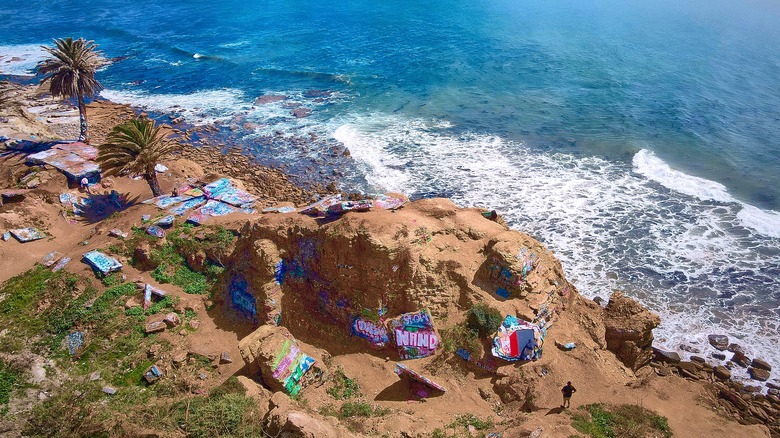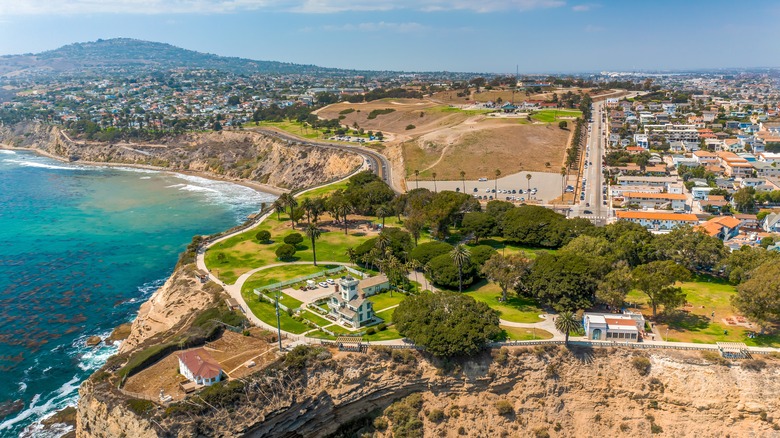The Scary Reason You Should Think Twice Before Visiting Los Angeles' Iconic Sunken City
Perhaps you've heard of it before, but even if you haven't, with a name like "The Sunken City," anyone can be sure there is some spooky lore. The Sunken City is one of Los Angeles' free, most intriguing, and somewhat lesser-known attractions, and for good reason. Once a thriving neighborhood in the 1920s, the area now stands (barely) as a haunting reminder of nature's power and the fragility of human structures. The Sunken City has become one of the state's urban legend of sorts, drawing adventurers, thrill-seekers, and curious tourists alike. However, despite its allure, there are some very real dangers associated with this crumbling 100-year-old site. Dangers that should make you think twice before deciding to explore this iconic yet perilous location.
The Sunken City's story begins in the early 1920s when developer George H. Peck built a small, upscale neighborhood with 39 luxury homes and bungalows on a picturesque cliff in San Pedro, Los Angeles. The area, known as Point Fermin, offered beautiful views of the Pacific and quickly became a desirable place to live. However, they didn't perform any geological testing before construction, and in 1929, disaster struck. A massive landslide caused a large portion of the neighborhood — some 40,000 square feet — to collapse into the ocean, taking homes, streets, and infrastructure with it. At its peak, the landslide moved 11 inches per day! Fortunately, no lives were lost, but the area was left in ruins, with cracked streets, toppled foundations, and remnants of what was once a bustling community. In this instance, the tragic history of the Sunken City isn't relegated to the past, as the unstable terrain of the area has lead to the deaths of several visitors to the site.
Dangers beneath the surface
Over the years, this dilapidated relic of a bygone era has become known as the Sunken City, attracting those fascinated by its eerie atmosphere and urban decay — it was even featured in "The Big Lebowski" (1998) famous ash spreading scene. Photographers, graffiti artists, and those who "live on the edge" have all flocked to the site despite the city's efforts to keep people out with $250,000 fences, "No Trespassing" signs, and routine sweeps by the LAPD, Park Rangers, and the Los Angeles Port Police.
Why? Because it's an active geological hazard. The landslide that created the Sunken City was not a one-time event. The cliffs of San Pedro are made of clay and loosely compacted sediment, and the ground beneath your feet is not as stable as it might appear. The risk of landslides and erosion is exacerbated by heavy rains. Despite the apparent stability of some parts of the Sunken City, the threat of the earth suddenly shifting, crumbling, or literally sinking away is very real.
In addition, the steep cliffs and unstable terrain make it easy to lose your footing, especially for those who are unfamiliar with the area, venturing out at night, or not paying close attention. One misstep could result in serious injury or worse. In 2007, USC kicker Mario Danelo plunged 100 feet down, and later that year 19-year-old Megan Maynard lost her footing and slipped down a 50-foot sheer cliff, both accidents resulting in untimely deaths. Throughout the years, there have been countless tragic incidents and fatalities.
Legal implications and safer alternatives
Besides landslides, injury, and death, there is also the matter of legal risks. The Sunken City, located at 500 W Paseo Del Mar, is officially and permanently closed to the public, and it's considered trespassing to enter the site. If you get caught, you'll have to pay a handsome "entry fee" of $450 to the LA County Court system, and your vehicle will be towed for $375 plus $175 per day for storage. Law enforcement patrols regularly and the surrounding community is not shy to file police reports. "Please find another place to have an adventure...a place that you can visit again in the years ahead for memories, rather than a memorial," advises Brian Humphrey, Firefighter and Specialist Public Service Officer with the Los Angeles Fire Department (via Reddit).
If you're interested in exploring the history and natural beauty of the San Pedro area, there are safer —and legal — alternatives to the Sunken City. Nearby, you can visit the Point Fermin Lighthouse for gorgeous coastline views or check out the Korean Friendship Bell and Fort MacArthur to learn more about local culture and history. For some hiking, explore the numerous trails at Palos Verdes Peninsula. However, if what you're really after are the most chilling abandoned places in Los Angeles (that don't involve trespassing), you can venture to the Old Zoo in Griffith Park, the notorious Murphy's Ranch, the Mentryville ghost town, or the Cold War era Nike Missile Control Site LA-96.

